IVDD In Dogs And When To Euthanize
Disc disease is a painful condition that can deeply impact a dog’s quality of life.
Severe IVDD (Intervertebral Discs Disease) can lead to unbearable discomfort and eventual paralysis, leading many owners to consider the possibility of humane euthanasia.
Saying goodbye to a dog with severe IVDD can be necessary in many cases, whether these pups are unable to pursue surgery or if their previous treatment has been unsuccessful.
In this article we will discuss some of the treatment and management options available for your dog with IVDD, and help you better understand when it may be time to say goodbye.
What Is IVDD In Dogs?
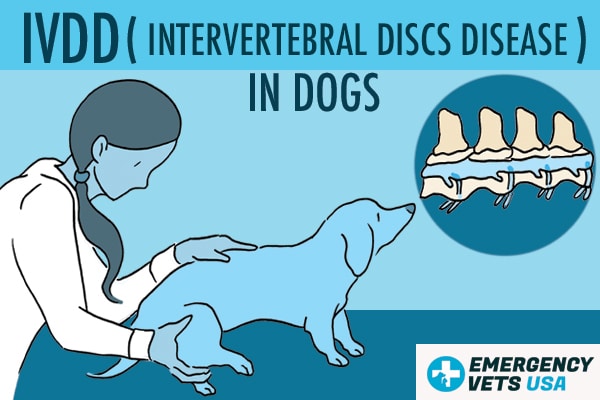
Intervertebral Discs Disease (IVDD) is a painful condition that involves the deterioration of the discs within the bones of the spine.
The intervertebral discs act as cushions between each spinal vertebrae, protecting the spine from the shock that comes with normal movement.
These tiny discs prevent the bones within the spine from making contact, allowing for the many movements our pups will participate in throughout their lives.
When a dog has IVDD, these discs will begin to break down over time.
Not only will these discs be put under stress due to the deterioration, but they may begin to slip and protrude out of place.
This is usually when our dogs start to lose their quality of life.
Read our article on when to euthanize a dog with a slipped disc for further understanding of this condition and how painful it can be.
These disc protrusions can begin to invade the spinal cord space, leading to a massive amount of pain as a result.
The spinal cord is incredibly fragile, and relies on the protection from the spinal vertebrae and intervertebral discs to prevent any trauma to the region.
Once these discs begin the deterioration process, everything will be compromised as a result.
How Do Dogs Develop IVDD?
In most cases, IVDD is an age related deterioration of the discs within the spinal vertebrae.
These discs will gradually harden over time, often leading to a sudden burst of these hardened discs through sudden activity or injury.
Though IVDD develops slowly over time, many owners do not notice the symptoms until a sudden injury to the discs occurs.
In other cases, IVDD can develop as a result of traumatic injury to the spine.
Trauma can cause the intervertebral discs to harden, leading to the degenerative process that follows.
This is why dogs with previous spinal trauma need to be monitored closely, as they are more at risk of developing a slew of degenerative conditions down the line.
Different Types Of IVDD In Dogs
When discussing IVDD in dogs, your vet may either diagnose your pup with type 1 or type 2 IVDD.
While both forms of the condition will lead to a similar fate, there are certain situations in which each form is most common.
Type 1 IVDD
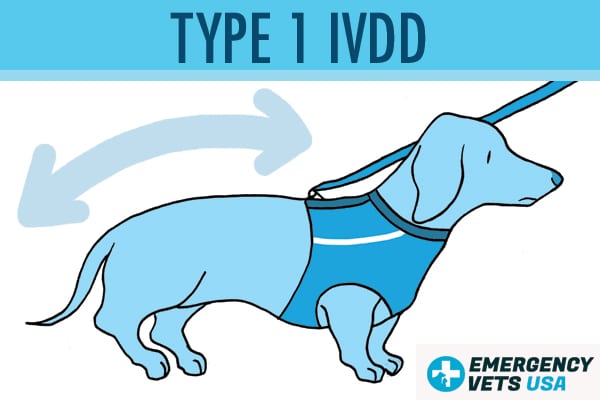
Type 1 IVDD is typically seen in small breed dogs with long backs.
Disc deterioration most often occurs within the mid-region of the spine, leading to hardening of the outer layer of the discs in this area.
These discs will be extremely vulnerable due to this hardening, causing the disc to eventually burst when a sudden injury occurs.
Type 2 IVDD
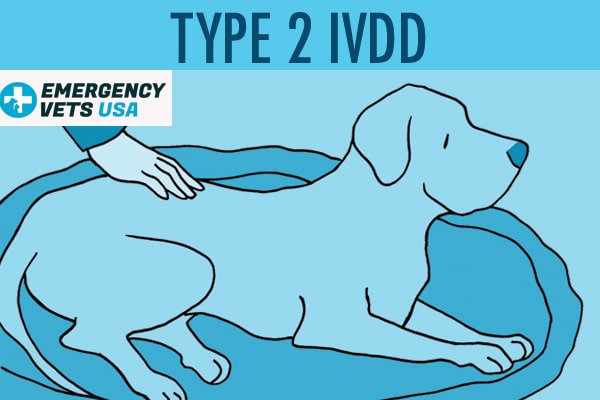
Type 2 IVDD is most often seen in older, large breed dogs.
These discs will begin to bulge and invade the spinal cord space, leading to the deterioration of the entire disc over time.
Most cases of type 2 IVDD will not involve a sudden injury, but rather a slow progression of symptoms over time.
Signs Of IVDD In Dogs
Dogs with IVDD may vary in symptoms based on the type of IVDD they have, and how far progressed their individual condition is.
Though you may see differing symptoms from pup to pup, there are some common signs of IVDD to be aware of when dogs are experiencing pain.
Some of the most common signs of IVDD in dogs include:
- Changes in normal gait
- Appearing unsteady on their feet
- Panting
- Shaking or trembling
- Appearing guarded around their abdomen and back
- Hunched appearance
- Decreased appetite
- Weakness in the limbs
- Holding their head at a lower position than usual
- Reluctance to participate in physical activities
- Crying out during activity, especially those involving jumping
- Difficulty with posturing to urinate or defecate
- Lethargy
- Depression or listlessness
- Paralysis
The symptoms listed above are evidence of discomfort in our canine friends, and will vary in severity from case to case.
If you notice any of the above symptoms in your canine friend, we recommend having your dog seen by your vet as soon as possible.
Not only is back pain excruciating for a pup to endure, these symptoms can progress to paralysis if left untreated.
Due to this potential risk, any signs of pain should always be taken seriously.
How To Diagnose IVDD In Dogs
When diagnosing IVDD in your canine friend, they will often rely on a few different diagnostic tools to help them paint a clear picture.
First, your veterinarian will ask you questions about your dog’s symptoms to gather a detailed history. They may ask you when the symptoms began, what symptoms you have noticed at home, or even how quickly these symptoms have progressed.
After your vet gathers a detailed history, they will then move onto the physical exam.
This physical exam will involve the vet palpating multiple spots of the body, helping them determine which area of the body is in pain.
They can also perform range of motion exercises and neurological exams, both of which can help them come to the potential diagnosis of IVDD.
If your vet is suspicious of IVDD, they will likely suggest a form of diagnostic imaging.
They can use x-rays to diagnose the narrowing of the space within the vertebrae, as well as a CT or MRI to examine each individual disc.
If your dog’s condition is complicated in any way, they may also refer your dog to a neurologist for more in depth examinations.
The 5 IVDD Stages In Dogs
Depending on the current stage of your dog’s IVDD, there are a few different treatment and management options on the table.
Successful treatment depends on early intervention before the condition progresses to eventual paralysis, or immediate intervention once severe symptoms set in.
To help you better understand the 5 stages of IVDD in dogs, let’s offer a brief description of each stage below.
Stage 1 IVDD
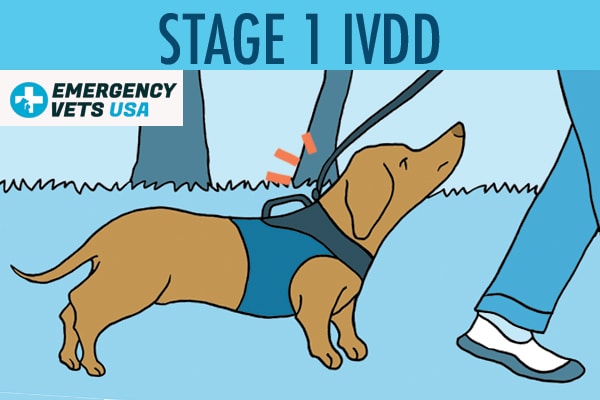
This stage involves mild pain and subtle symptoms, and often resolves quickly with medical management.
These pups may display minor changes in gait, some stiffness in the neck, or even pain when pushing down on the spine.
Stage 2 IVDD
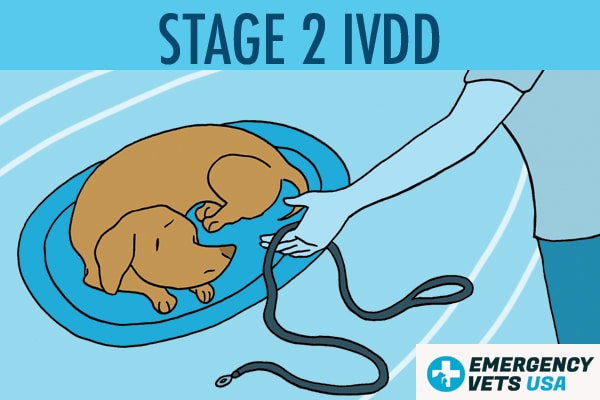
This stage involves mild to moderate pain, as well as subtle symptoms in most cases.
This stage will also resolve quickly with medical management, as long as owners act quickly from the time symptoms develop.
Dogs with stage 2 IVDD may experience changes in gait, neck stiffness, pain when pushing on the spine, and even reluctance to engage in activities.
Stage 3 IVDD
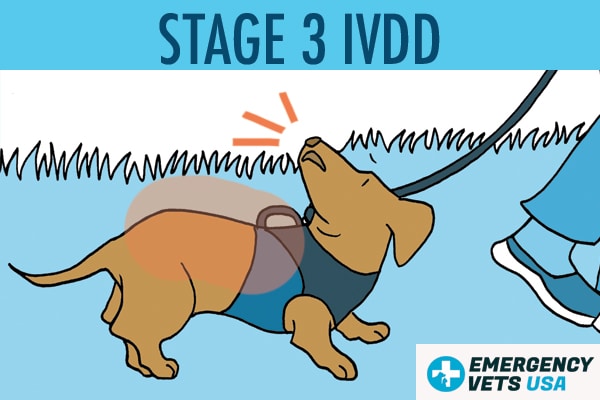
This stage involves moderate to severe pain for the dog affected.
This is when dog owners will begin to notice obvious signs of discomfort, ranging from crying out in pain to weakness of the limbs.
Some of these cases can still be treated with medical management, but owners will need to be strict with cage rest and medications to prevent the need for surgery.
Stage 4 IVDD

This stage involves significant deterioration of the discs and protrusion of a disc into the spinal cord space.
These dogs will either present in severe pain, or will be experiencing the beginning stages of paralysis.
These dogs can still be treated with surgical repair of the disc, but their prognosis can be guarded. Successful treatment is dependent on immediate medical intervention.
Stage 5 IVDD
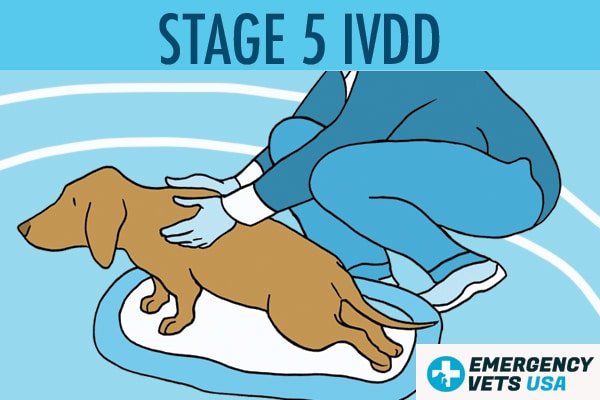
This stage involves full paralysis of the limbs and loss of deep pain of the limbs.
Some dogs can have a full recovery with surgical repair, but their prognosis is very guarded.
IVDD Treatment Options For Dogs
Once your veterinarian determines the stage of your dog’s IVDD, they can offer the most accurate prognosis based on their current situation.
To introduce you to the different treatment options available to your pup, let’s list the standard treatment and management options below.
- Exercise restriction: Exercise restriction will involve strict rest for 8-12 weeks, allowing the disc to heal without further agitation. This will have to occur whether your dog is just diagnosed with IVDD, or they have just undergone surgery for their condition.
- Medication: Medical management involves treating your dog with steroids, anti inflammatory medications, and muscle relaxers. This in addition with strict rest can help your pup recover from their current injury.
- Spinal Surgery: Spinal surgery is necessary for dogs with late stage IVDD, or those who are experiencing forms of paralysis. This surgery involves correcting the injured disc in question, as well as tending to any other complications present.
It’s important to note that fast action is essential in offering your dog a full recovery.
IVDD can progress to paralysis quickly if effective treatment is not implemented quickly.
Not only can IVDD lead to eventual paralysis when veterinary care is not sought immediately, but the chance of reversing paralysis is less likely as more time passes.
From the moment you notice any abnormal symptoms in your dog, we suggest contacting your veterinarian.
What If My Dog With IVDD Does Not Have Surgery?
When a dog is diagnosed in the late stages of IVDD, some owners wonder what could happen if they turn down spinal surgery.
Surgery is not an option for every furry friend, whether it is due to the owner’s finances or the dog not being a great candidate for the procedure.
Though it is not as common, some dogs will recover without the need for corrective spinal surgery.
These dogs will need to undergo strict cage rest for 8-12 weeks, as well as aggressive medical management to manage their pain and inflammation.
If these dogs have a chance at recovery, you will typically see evidence of improvement within 1 week. It can take an additional 8-12 weeks for these dogs to make a full recovery.
However, most dogs that do not receive spinal surgery once paralysis has begun will not regain function of their limbs.
These dogs may also experience significant and chronic pain, leading many owners to the decision of euthanasia.
If you cannot explore surgery and your dog continues to decline, we highly suggest having a quality of life discussion with your vet.
When To Euthanize A Dog With IVDD
Our dogs cannot tell us how they feel, so it can be challenging to know when they are suffering. Dogs in the late stages of IVDD can begin to experience significant pain, so it’s up to us to decipher the clues they display in their behavior.
Many owners of dogs with IVDD will be faced with the potential of euthanasia, so it’s important to be aware of the signs of a dog suffering in this condition.
To help you make the best decision for your pup, let’s list a few of the most common symptoms a dog may display when suffering from their IVDD.
- Extreme weakness of the limbs
- Dragging the limbs
- Paralysis of the limbs
- Disinterest in activities they typically enjoy
- Anorexia
- Listlessness or depression
- Leaking urine or inability to control their bladder
- Inability to urinate without manual expression
- Frequent crying out in pain
- Crying out in pain when they are touched
- Inability to move around your home on their own
If your dog is experiencing any of the above symptoms after being diagnosed with IVDD, it may be time to have a quality of life discussion with your vet.
This discussion can refer to dogs that have already pursued aggressive medical or surgical treatment, or for those who are unable to receive treatment for any reason.
Your veterinarian knows your dog’s situation best, so we suggest following their guidance when discussing the possibility of euthanasia for your pup.
They can help you explore any other treatment options on the table, or the potential for saying goodbye to your beloved companion when needed.
The final decision on when to euthanize your dog with IVDD is up to you. You as the caretaker of your dog will know them better than anyone else.
Sometimes we don’t want to let our loved ones go, which is why seeking the advice of your family’s veterinarian can help you understand when it’s time for euthanasia.
Final Thoughts
IVDD has the potential to cause significant pain for your furry companion.
If you are ever struggling with the thought of saying goodbye to your dog with IVDD, we suggest having an honest discussion with your veterinarian.

My name is Amber. I am a dedicated animal lover that turned my passion into my career. I am a Licensed Vet Tech with 12 years of experience in veterinary medicine, but I recently took my career online to help spread accurate information on animal care. With how vast the online world is, I have a strong desire to ensure that the reader always walks away with helpful pet advice. With the experience I’ve gained from my time in this field, I have been able to travel the world, offering my services to as many animal rescues as I can find. If I am not at my laptop, or back home visiting family, you can find me somewhere in the world, cuddling every furry friend that I can find! More About Us
